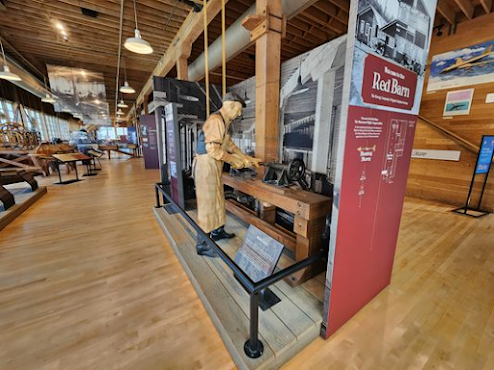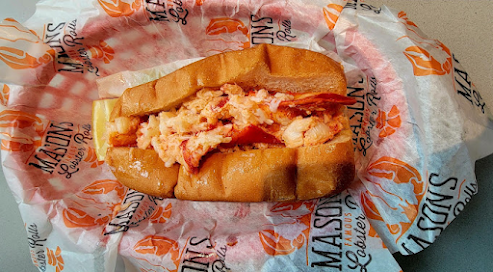Savoring The Time In Seattle
8.8 King County Boeing Field
Sunday 2024-04-14
8.8 King County
It is one of three Washington counties that are included in the Seattle metropolitan area along with Snohomish County to the north and Pierce County to the south. About two-thirds of King County's population lives in Seattle's suburbs, which largely developed in the late 20th century and early 21st century as bedroom communities before becoming job centers for the technology industry.
Direction to Museum of Flight
1. Downtown → Museum of Flight
From Space Needle, walk 11 minutes to 3rd Ave & Cedar St, Seattle, take BUS 124 to East Marginal Way S & S 96th Pl; walk 2 minutes to Museum of Flight.
Start: Head to the Beacon Hill Station on the Link Light Rail.
Destination: Take the Link Light Rail towards the Tukwila International Blvd Station.
Transfer: At the Tukwila International Blvd Station, transfer to the 49 bus towards the Museum of Flight.
Museum of Flight: Get off at the Museum of Flight bus stop.
Boeing Field
King County International Airport
WA 98108, United States
https://boeing-field.com/
King County International Airport
WA 98108, United States
https://boeing-field.com/
King County International Airport (IATA: BFI, ICAO: KBFI, FAA LID: BFI), commonly Boeing Field, is a public airport owned and operated by King County, 5 mi (8.0 km) south of downtown Seattle, in the U.S. state of Washington. The airport is sometimes referred to as KCIA (King County International Airport), but it is not the airport identifier.
▲ The Red Barn Boeing's original manufacturing plant
Museum of Flight
Boeing Field
King County International Airport
9404 E. Marginal Way
Seattle, Washington, U.S.
https://www.museumofflight.org/King County International Airport
9404 E. Marginal Way
Seattle, Washington, U.S.
The Museum of Flight is a private non-profit air and space museum in the Seattle metropolitan area. It is located at the southern end of King County International Airport (Boeing Field) in the city of Tukwila, immediately south of Seattle. It was established in 1965 and is fully accredited by the American Alliance of Museums. As the largest private air and space museum in the world, it also hosts large K–12 educational programs.
The museum attracts over 500,000 visitors every year, and also serves more than 140,000 students annually through its onsite programs: a Challenger Learning Center, an Aviation Learning Center, and a summer camp (ACE), as well as outreach programs that travel throughout Washington and Oregon.
On its grounds is the Personal Courage Wing (PCW) with 28 World War I and World War II aircraft from several countries including Germany, Russia, and Japan.
There is also the "Red Barn", a registered historic site also known as Building No. 105. Built in 1909, the building was used during the early 1900s as Boeing's original manufacturing plant. Through photographs, film, oral histories, and restoration of work stations the exhibits in the Red Barn illustrate how wooden aircraft structure with fabric overlays were manufactured in the early years of aviation and provides a history of aviation development through 1958.
In June 2007 the museum opened a new space exhibit: "Space: Exploring the New Frontier", which traces the evolution of space flight from the times of Robert Goddard to the present and into future commercial spaceflight.
The museum attracts over 500,000 visitors every year, and also serves more than 140,000 students annually through its onsite programs: a Challenger Learning Center, an Aviation Learning Center, and a summer camp (ACE), as well as outreach programs that travel throughout Washington and Oregon.
On its grounds is the Personal Courage Wing (PCW) with 28 World War I and World War II aircraft from several countries including Germany, Russia, and Japan.
There is also the "Red Barn", a registered historic site also known as Building No. 105. Built in 1909, the building was used during the early 1900s as Boeing's original manufacturing plant. Through photographs, film, oral histories, and restoration of work stations the exhibits in the Red Barn illustrate how wooden aircraft structure with fabric overlays were manufactured in the early years of aviation and provides a history of aviation development through 1958.
In June 2007 the museum opened a new space exhibit: "Space: Exploring the New Frontier", which traces the evolution of space flight from the times of Robert Goddard to the present and into future commercial spaceflight.
The Museum of Flight is on the southwest corner of the field. Among the aircraft on display is the first Boeing 747, the third Boeing 787, and an ex-British Airways Concorde, lent to the museum from BA, a supersonic airliner that landed at Boeing Field on its first visit to Seattle on November 15, 1984. Aircraft on the airfield can be seen from the museum.
The T. A. Wilson Great Gallery is a 3 million-cubic-foot, six-story, glass-and-steel exhibit hall currently containing 39 full-size historic aircraft, including the nine-ton Douglas DC-3 hang from the space-frame ceiling in flight attitude. Dramatically lit at night, the Gallery is a stunning architectural achievement full of aircraft that trace the history of the first century of flight.
William E. Boeing Red Barn
The William E. Boeing Red Barn, with its warm wood tones and historic exhibits, reflects the romantic early days of aviation. The two-story barn is the historic birthplace of the Boeing Airplane Company. There is a warmth and a human scale to the simple, turn-of-the-century, post-and-beam architecture, while multiple sets of wooden mullioned windows and skylights bring in natural light.
J. Elroy McCaw Personal Courage Wing
The J. Elroy McCaw Personal Courage Wing is a two-story gallery that highlights the stories of courage, dedication, heroism and the triumph of the human spirit of those involved in fighter aviation in World War I and World War II. This 88,000-square-foot addition opened on June 6, 2004 (the 60th anniversary of D-Day) and showcases 28 immaculately restored WWI and WWII fighter planes across two galleries, including one of the finest collections of historic fighters found anywhere in the world—the internationally known Champlin Fighter Collection.
Through state-of-the-art exhibits, interactive experiences, and flight simulations the Personal Courage Wing exhibits tell the stories of not only those who flew, but the people who designed, built and maintained these amazing aircraft. Unlike the Museum's Great Gallery, the Personal Courage Wing is essentially a black box, designed to provide necessary protection from harmful ultraviolet light that can damage fragile items like documents and uniforms.
Through state-of-the-art exhibits, interactive experiences, and flight simulations the Personal Courage Wing exhibits tell the stories of not only those who flew, but the people who designed, built and maintained these amazing aircraft. Unlike the Museum's Great Gallery, the Personal Courage Wing is essentially a black box, designed to provide necessary protection from harmful ultraviolet light that can damage fragile items like documents and uniforms.
Charles Simonyi Space Gallery
The Charles Simonyi Space Gallery includes multi-sensory exhibits that emphasize stories from the visionaries, designers, pilots and crews of the Space Shuttle program and are designed to educate and inspire all ages.
In partnership with SRG Partnership architects, Sellen Construction Company engineers and Seneca Group, The Museum of Flight designed the 15,500-square-foot gallery, which opened in 2011 and now houses NASA's Space Shuttle Full Fuselage Trainer.
Aviation Pavilion
The Museum of Flight's Aviation Pavilion is a covered, open-air gallery with 19 rare and unique commercial and military airplanes. The 3-acre display focuses on the dramatic development of large aircraft and commercial airliners from the 1930s to the present. The Pavilion also offers the first-ever exhibit about the business of air freight. The FedEx Air Cargo exhibit, built from the fuselage of a former FedEx Boeing 727 freighter, is a highly interactive, behind-the-scenes exploration into the world of air deliveries.

Vietnam Veterans Memorial Park
The Vietnam Veterans Memorial Park is the result of the Project Welcome Home campaign, which provided support for the restoration of the park's centerpiece, the B-52G Stratofortress 59-2584 Midnight Express, and the transformation of a previously vacant lot into a space for reflection and remembrance of the sacrifices of Vietnam War veterans.
The B-52 flew during Operation Linebacker II and sat quietly at Paine Field in Everett, Washington for 28 years before Project Welcome Home's restoration gave it a new life. Visitors can admire the plane up close while also remembering the nearly 10,000 other U.S. military aircraft lost during the war.
Joining the plane is a Vietnam airman statue carrying a folded American flag created by artist James J. Nance. The airman represents all those who returned home from combat, while the flag represents those who did not return.
The Park also features a Tribute Wall with plaques that carry the names of many who served during the Vietnam War. The plaques are personalized with names, military rank and other information, and appear on the wall along the footpath around the B-52.
The Charles Simonyi Space Gallery includes multi-sensory exhibits that emphasize stories from the visionaries, designers, pilots and crews of the Space Shuttle program and are designed to educate and inspire all ages.
In partnership with SRG Partnership architects, Sellen Construction Company engineers and Seneca Group, The Museum of Flight designed the 15,500-square-foot gallery, which opened in 2011 and now houses NASA's Space Shuttle Full Fuselage Trainer.
The Museum of Flight's Aviation Pavilion is a covered, open-air gallery with 19 rare and unique commercial and military airplanes. The 3-acre display focuses on the dramatic development of large aircraft and commercial airliners from the 1930s to the present. The Pavilion also offers the first-ever exhibit about the business of air freight. The FedEx Air Cargo exhibit, built from the fuselage of a former FedEx Boeing 727 freighter, is a highly interactive, behind-the-scenes exploration into the world of air deliveries.

The Vietnam Veterans Memorial Park is the result of the Project Welcome Home campaign, which provided support for the restoration of the park's centerpiece, the B-52G Stratofortress 59-2584 Midnight Express, and the transformation of a previously vacant lot into a space for reflection and remembrance of the sacrifices of Vietnam War veterans.
The B-52 flew during Operation Linebacker II and sat quietly at Paine Field in Everett, Washington for 28 years before Project Welcome Home's restoration gave it a new life. Visitors can admire the plane up close while also remembering the nearly 10,000 other U.S. military aircraft lost during the war.
Joining the plane is a Vietnam airman statue carrying a folded American flag created by artist James J. Nance. The airman represents all those who returned home from combat, while the flag represents those who did not return.
The Park also features a Tribute Wall with plaques that carry the names of many who served during the Vietnam War. The plaques are personalized with names, military rank and other information, and appear on the wall along the footpath around the B-52.

Mason's Famous Lobster Rolls
1307 1st Ave, Seattle, WA 98101, United States
❤ Classic Lobster Roll
Pike Place Chowder Pike Place Market
1530 Post Alley Walk Wy, Seattle,
1530 Post Alley Walk Wy, Seattle,
Pike Place Chowder Pacific Place
600 Pine St, Seattle, WA 98101, United Stateshttps://order.toasttab.com/online/pike-place-chowder-600-pine-st
I walked from Space Needle to take Monorail from Seattle Centre to Westlake Center. From there, I walked 10 minutes to Hilton Garden Inn Seattle Downtown where I stayed.
Monorail was super fast. It was a fun ride!
Back home to Vancouver
Next, Carefree Time In Portland
1.7 Arrival
Publisher: Kar Discover






























































































































No comments:
Post a Comment